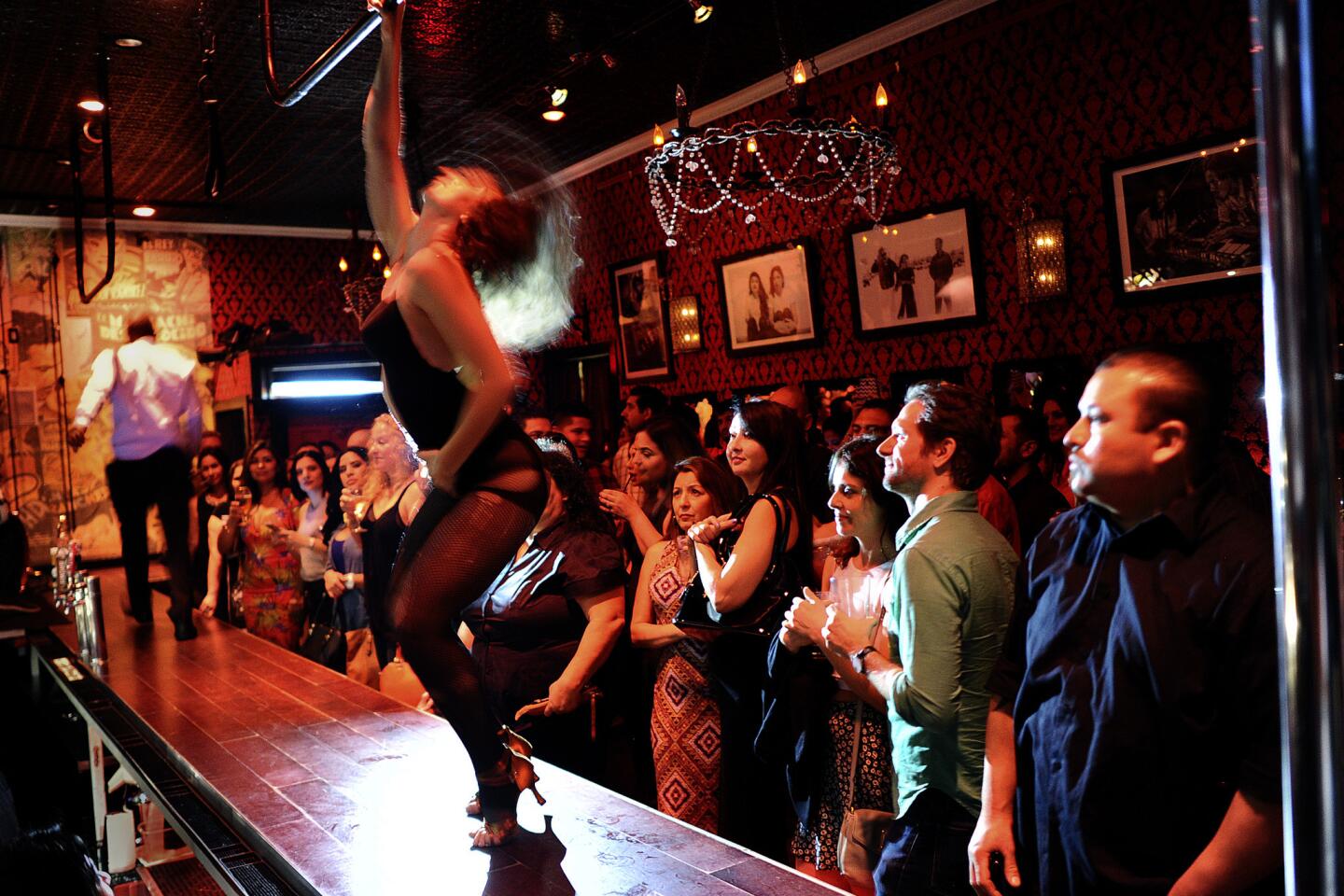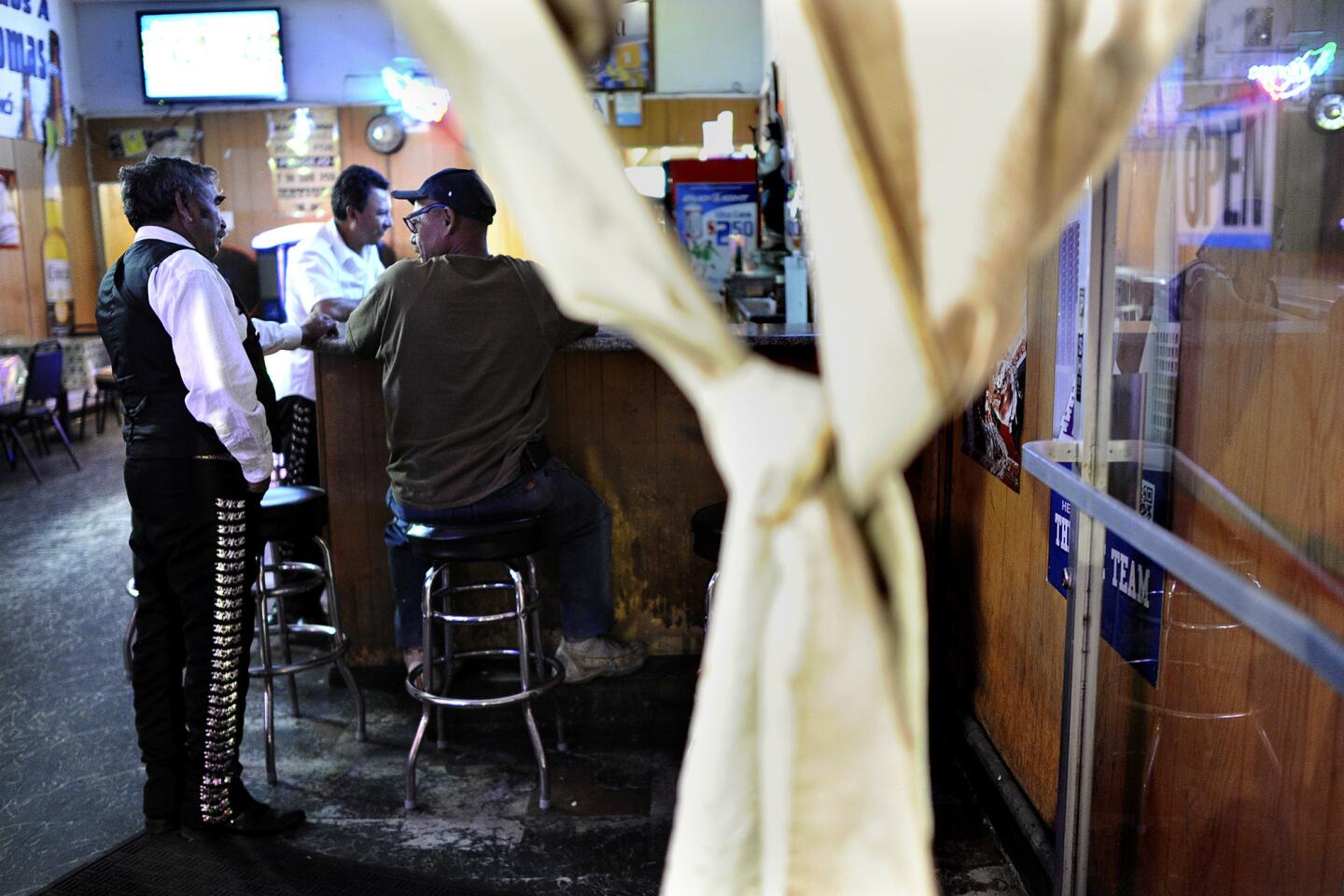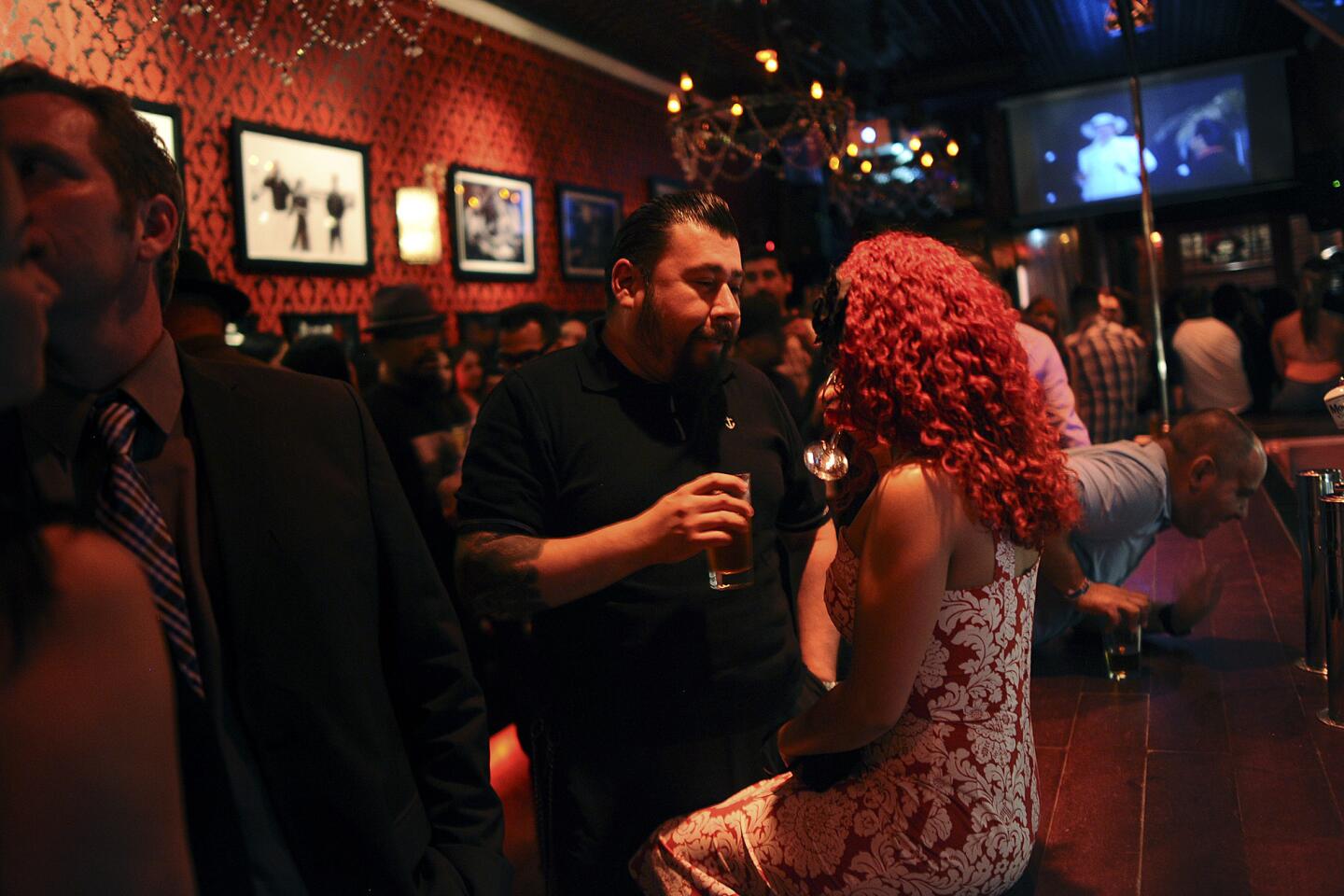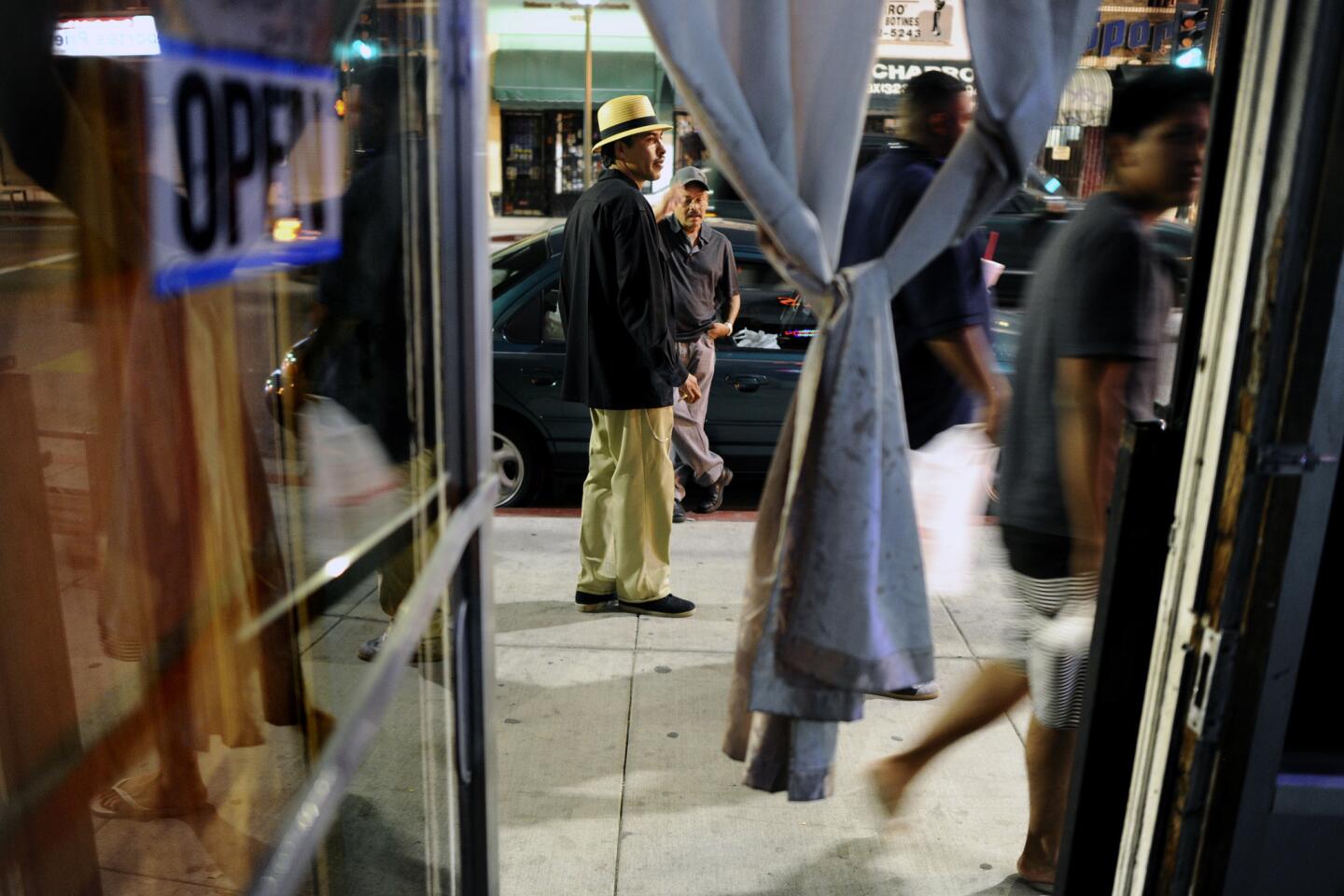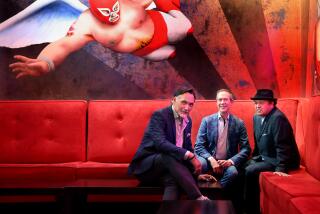Great Read: Two bars -- one Mexicano, one ‘Chipster’ -- show how an L.A. neighborhood is changing
The beers pile up in front of the men at the bar in Las Palomas as Los Tigres del Norte’s “Somos Mas Americanos” blasts from the jukebox: “They’ve screamed at me a thousand times to go back to my land.” After a day sweating at an auto body shop, Hugo Vazquez pops open a can of Tecate and waits for a Mexican league soccer game to start.
Next door at the Eastside Luv wine bar, Justin Timberlake’s “Sexyback” pumps from the speakers as young women in heels, skirts, fancy tops and leggings chat, playfully sprinkling Spanish into their English. At a table with a “reserved” card, administrative assistant Melissa Corral celebrates her birthday, sipping her own Tecate daintily from a glass.
When Las Palomas opened on 1st Street near Boyle Avenue in 1963, a still multicultural Boyle Heights that had been home to Jews, Russians, Japanese and Italians was becoming the center of Los Angeles’ Mexican American culture. When Eastside Luv opened in 2006, the neighborhood was hearing increasing chatter about imminent gentrification.
Almost a decade later, the two bars sit side-by-side like an immigrant father and his Americanized son, springing from the same root but not quite always getting each other. The Mexicano and the “Chipster” —Chicano hipster.
“We’re not a Mexican bar and we’re not an American bar. We really are a Mexican American bar,” says Guillermo Uribe, the owner of Eastside Luv. “There’s so many Mexican Americans, and we’re all coming to this point where we’re looking for businesses that are catering to us. That’s what Eastside Luv does.”
Jose Morales, owner of Las Palomas for the last nine years, says young men and women occasionally come slumming from the bar next door. Tellingly, though, the migration is a one-way street. Those in the Las Palomas crowd, often traveling musicians and day laborers, virtually all of them Mexican immigrants, don’t seek adventure in Eastside Luv.
Looking down at his Saturday night outfit of T-shirt and shorts, Vazquez smiles skeptically and says: “I feel like they’re not going to let me in.”
::
No corner of Boyle Heights wears the still-embryonic face of gentrification more than the one where the two bars sit, right next door to a renovated Mariachi Plaza and a Gold Line subway station. The bars are across the street from a coffeehouse as well as the M Bar/The Metropolitan, where bands play.
Eastside Luv’s Uribe calls what’s been happening in Boyle Heights “gentefication” — a pun on the Spanish word for “people” — because much of the change is spurred by Latinos with higher incomes and education levels who often have connections to the neighborhood.
“Every community always has room for improvement,” Uribe says. “If we are going to experience gentrification … then it might as well be from people that are from the community, that are familiar with this Mexican American community.”
Anayansi Diaz-Cortes, 35, a radio reporter who lives in West Adams, sits at one of the reserved tables early in the night. Originally from Mexico City, she grew up in Miami and says Eastside Luv connected her to “a side of Los Angeles I didn’t know, that was a little hipster, but felt super regional and local and tied to a neighborhood.”
Outside the bar, John Carlos De Luna checks IDs while simultaneously appraising each person’s outfit choice.
“You wouldn’t happen to have a collared shirt in the car, right?” De Luna asks a man in a long-sleeved baseball shirt and jeans. “There’s a dress code tonight.”
De Luna, born and raised in Boyle Heights, says he believes the bar creates a space for people to feel proud to be Chicano. When Mexican songs play, the crowd seems to be moved on the hardwood dance floor by a jolt of nostalgia and a joy bequeathed by their parents and grandparents.
“Instead of going to places where we’re tolerated, this is really a place where we’re celebrated,” De Luna says.
To him, Eastside Luv represents “Chicanolandia,” he says. Las Palomas, he says, represents Mexico.
::
Bartender Dulce-Maria Suarez is the only woman in Las Palomas early this evening. Decked out in a short, tight, black-and-white dress, she toasts the patrons with a can of Modelo.
The only source of entertainment is the jukebox and the soccer games on the bar’s TV sets, both occasionally drowned out by the chatter of the men at the bar — some of whom are getting more soused by the minute.
A man pops the top on his third Bud Light, trying to hold a conversation with his neighbor, who is slumped over and glassy-eyed beside him. Behind the bar, signs line the mirrored glass: Por favor, no bicicletas en el negocio gracias. No bicycles inside please.
Luis Hernandez, 76, heads to his bicycle after walking out the bar’s curtained door. The Jalisco native, wearing black boots and a white cowboy hat, has been coming to Las Palomas almost every day for 10 years.
“We’re in Las Palomas, if you want to come,” Hernandez tells a friend on the phone. “No, there’s no karaoke!” he snaps.
He glances over at Eastside Luv, where De Luna is checking IDs. Hernandez scoffs that ageless scoff of a generational divide.
“They’re not Mexican,” Hernandez says of the well-dressed mostly thirtysomethings. “I don’t know what they are.”
Francisco Irigoyen drinks a Budweiser and munches on peanuts he bought from a street vendor making the rounds outside. The 64-year-old is scruffy-faced, his skin tan from standing for hours outside Home Depot, looking for the odd construction gig.
To him the patrons at Eastside Luv look like gueros — referring to their relatively light complexions.
“They wouldn’t let me in,” he says with a laugh. But Irigoyen, who is dressed in jeans and a T-shirt with the words “Chichen Itza Mexico,” says he doesn’t mind. Las Palomas is the kind of place where owner Morales has been known to take IOUs and drive customers home when they’ve had a few too many.
“I feel very comfortable here. We’re all friends.”
::
It’s just past midnight, and a jazz man is playing the saxophone at Eastside Luv’s crowded bar. A woman in fishnet stockings joins him, performing the weekly Saturday night burlesque show.
She twirls on a pole and grabs bars attached to the ceiling, making her way across the makeshift stage. The woman grabs a can of beer from someone in the crowd and takes a swig as people cheer.
The night begins to wind down and a woman stands up on a chair, singing slightly off-key to Beyoncé’s “Flawless.”
As the bar begins to close, a half-dozen men and women polish off their drinks, a few of them woozy. As they leave, they snap photos to post on Instagram.
Over at Las Palomas, a few tipsy men dressed in their regal mariachi pants and jackets sing: Para olvidar este dolor. To forget this pain ...
The bar is virtually empty now, and their table is littered with Tecates and Modelos.
Suarez, the bartender, is settling up tabs as the 2 a.m. closing time approaches. Five mariachis look as if they have nowhere to go. Suarez begins to sweep, making no move to hurry them along.
Finally, as the jukebox is unplugged for the night, the mariachis say their goodbyes and begin to straggle out. Two of them linger, singing a final few lyrics, and then stumble out the door.
More to Read
Start your day right
Sign up for Essential California for news, features and recommendations from the L.A. Times and beyond in your inbox six days a week.
You may occasionally receive promotional content from the Los Angeles Times.
